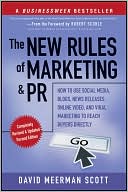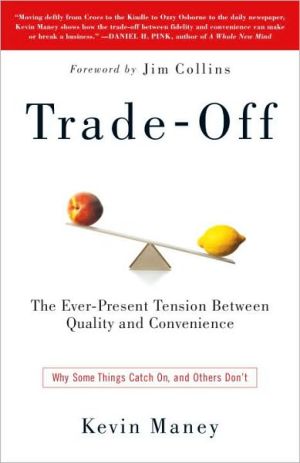Why Things Bite Back: Technology and the Revenge of Unintended Consequences
In this perceptive and provocative look at everything from computer software that requires faster processors and more support staff to antibiotics that breed resistant strains of bacteria, Edward Tenner offers a virtual encyclopedia of what he calls "revenge effects"--the unintended consequences of the mechanical, chemical, biological, and medical forms of ingenuity that have been hallmarks of the progressive, improvement-obsessed modern age. Tenner shows why our confidence in technological...
Search in google:
In this perceptive and provocative look at everything from computer software that requires faster processors and more support staff to antibiotics that breed resistant strains of bacteria, Edward Tenner offers a virtual encyclopedia of what he calls "revenge effects"—the unintended consequences of the mechanical, chemical, biological, and medical forms of ingenuity that have been hallmarks of the progressive, improvement-obsessed modern age. Tenner shows why our confidence in technological solutions may be misplaced, and explores ways in which we can better survive in a world where despite technology's advances—and often because of them—"reality is always gaining on us." For anyone hoping to understand the ways in which society and technology interact, Why Things Bite Back is indispensable reading. "A bracing critique of technological determinism in both its utopian and dystopian forms...No one who wants to think clearly about our high-tech future can afford to ignore this book."—Jackson Lears, Wilson Quarterly Publishers Weekly An examination of technology's unforeseenand often unpleasantconsequences, which PW called "thought-provoking." (July)
From easily reversible eyestrain to crippling back, hand, and wrist pain, the physical problems of computing have important things in common. They are incremental. They develop slowly, often without a noticeable onset. There can be a sudden crisis of disabling pain, the result of conditions that have persisted for weeks or months. These are only indirectly measurable. X-rays and other imaging can show anomalies consistent with pain, but men and women with similar physical images may not have similar feelings.\ Above all, these conditions are shaped socially. Political conservatives usually insist on the existence of an objective reality and deny that scientific and even technological knowledge is socially constructed. But partly because there is no "dolorometer," no recognized test for pain -- only at best devices that may reveal suspiciously inconsistent responses -- conservatives and especially neoconservatives deplore the economic cost of computer-related claims and see neurosis at work, if not fraud. Liberals, who otherwise perceive the self-interest of medical providers in "new" syndromes and diagnoses, consider computer-related illness to be objectively real. Both sides would agree that injury rates tend to be higher where work is more stressful. Organizations using similar hardware and software have had such different experience with injuries that social processes must be responsible for part of the difference. But nobody understands yet what the processes may be and how they operate.\ In the outbreak of reported cumulative trauma disorders in Australia in the 1980s -- "the largest, most costly and most prolonged industrial epidemic in world history," according to one medical critic there -- there was agreement that medical attitudes were part of the problem and actually helped make it worse. But who was creating the unintended consequences? Was it the office workers who were reporting it, or their labor and feminist allies who helped promote oversensitivity to minor symptoms and even encourage outright malingering? (Australian trade unions are among the world's most socially and politically active, and workers' compensation laws reflect labor's political influence.) Or were sympathetic physicians helping "the powerless and dependent, and those who cannot otherwise express their righteous rage at their supervisors, employers and spouses," to use their "exquisitely symbolic pain and incapacity" to communicate distress, as one Australian doctor has suggested? Or were skeptical physicians helping to create chronic symptoms by refusing to take early reports seriously and putting the burden of proof on patients, as other analysts have argued? Either way, the epidemic was in part an unintentional consequence of medicalizing what the Australians called (following Commonwealth practice) repetitive strain injury.\ Not paying attention leads to injuries. But focusing on the physical problems of computing or anything else might have amplified the symptoms. Are sufferers hard workers who have driven themselves too far, coming forward reluctantly only when the pain is unendurable? Or are they consciously or unconsciously trying to escape from responsibility by medicalizing their problems? Questions that begin with seatpans and backrests, forward and backward tilts, microswitch clicks and wrist supports turn out to have answers that are psychological, organizational, and even political. The question is whether the ethical burden is on employers to control stress even at the expense of profits and "competitiveness," or on workers (whether data tabulators or editorial writers) to stiffen their upper lips as well as their lower backs.\ From the Hardcover edition.
Preface1Ever Since Frankenstein32Medicine: Conquest of the Catastrophic263Medicine: Revenge of the Chronic474Environmental Disasters: Natural and Human-Made715Promoting Pests956Acclimatizing Pests: Animal1167Acclimatizing Pests: Vegetable1408The Computerized Office: The Revenge of the Body1619The Computerized Office: Productivity Puzzles18410Sport: The Risks of Intensification21011Sport: The Paradoxes of Improvement23212Another Look Back, and a Look Ahead254For Further Reading279Notes283Index331
\ Publishers Weekly - Publisher's Weekly\ An examination of technology's unforeseenand often unpleasantconsequences, which PW called "thought-provoking." (July)\ \ \ \ \ Library JournalBelievers in Murphy's Law-"if something can go wrong, it will"-might think this book proves it. Historian of science Tenner, who holds a visiting research appointment at Princeton University's Department of Geological and Geophysical Sciences, describes the "revenge effect," an adverse consequence occurring when "new structures, devices, and organisms react with real people in real situations in ways we could not foresee." There are innumerable examples, e.g., sophisticated medical procedures save lives but are expensive and leave patients vulnerable to other unpleasant complications, technologies to improve agricultural yield inadvertently lead to erosion, and office computerization has fostered a new epidemic of carpal tunnel syndrome. Tenner chronicles dozens of such cases, which are seen as almost inevitable owing to the complexity of many systems. With hindsight, some of his examples seem obvious-for example, traffic jams resulted from the mass production of automobiles-and Tenner's point is clear by the third chapter. Still, his conclusion that we must recognize revenge effects and act earlier to avert them is worth heeding. For general science collections.-Gregg Sapp, Univ. of Miami Lib.\ \ \ BooknewsTenner (Princeton U.) examines the unintended consequences of mechanical, chemical, biological, and medical advances in the 20th century. He looks at aspects of a pattern of paradox and "revenge effects," detailing phenomenon such as low-tar cigarettes that discourage quitting, and the occurrence of the Chernobyl meltdown during a safety test. Of interest to technophiles, technophobes, and general readers. Annotation c. Book News, Inc., Portland, OR (booknews.com)\ \ \ \ \ DuncanEarly in Chapter 1 (entitled, by the way, "Ever Since Frankenstein"), Why Things Bite Back sets forth its central premise and agenda: "Wherever we turn we face the ironic unintended consequences of mechanical, chemical, biological, and medical ingenuity -- revenge effects, they might be called." The book surveys these revenge effects of modern technology across a wide spectrum of contexts and applications, organizing them under the general headings of health care, the environment, agriculture and pest control, the computerized office, and sports. The two chapters on computers and information systems are disappointingly sketchy. They focus primarily on repetitive stress injuries, eyestrain, software viruses, and the so-called "productivity paradox" (which, of course, is not turning out to be such a paradox after all). Some obvious targets for an in-depth analysis -- the Y2K crisis and fly-by-wire systems -- are completely ignored. The computing chapters, unlike the rest of the book, have distinct neo-Luddite overtones, and are not even consistent internally, criticizing TEX on one hand and graphical user interfaces on the other. However, the bibliography provides a good starting point for further reading in this area. Probably the most telling commentary on Why Things Bite Back is the time it took me to slog my way through it. I bought it on the strength of the title and clever cover photo, which unfortunately turned out to be its most compelling features. The author plods through superficial, diffident examinations of a seemingly endless litany of revenge effects, giving a discussion of chronic illness equal time with the economic impact of high-tech tennis rackets and golf balls. I'm normally a very fast reader, but I picked this book up and put it down for over a year before I finally finished it off. Revenge effects are fascinating, pervasive, and critically important, but they need a more passionate, more insightful treatment than they found here. -- Ray Duncan\ \ \ \ \ Ray DuncanWhy Things Bite Back\ Early in Chapter 1 (entitled, by the way, "Ever Since Frankenstein"), Why Things Bite Back sets forth its central premise and agenda: "Wherever we turn we face the ironic unintended consequences of mechanical, chemical, biological, and medical ingenuity -- revenge effects, they might be called." The book surveys these revenge effects of modern technology across a wide spectrum of contexts and applications, organizing them under the general headings of health care, the environment, agriculture and pest control, the computerized office, and sports. The two chapters on computers and information systems are disappointingly sketchy. They focus primarily on repetitive stress injuries, eyestrain, software viruses, and the so-called "productivity paradox" (which, of course, is not turning out to be such a paradox after all). Some obvious targets for an in-depth analysis -- the Y2K crisis and fly-by-wire systems -- are completely ignored. The computing chapters, unlike the rest of the book, have distinct neo-Luddite overtones, and are not even consistent internally, criticizing TEX on one hand and graphical user interfaces on the other. However, the bibliography provides a good starting point for further reading in this area. Probably the most telling commentary on Why Things Bite Back, is the time it took me to slog my way through it. I bought it on the strength of the title and clever cover photo, which unfortunately turned out to be its most compelling features. The author plods through superficial, diffident examinations of a seemingly endless litany of revenge effects, giving a discussion of chronic illness equal time with the economic impact of high-tech tennis rackets and golf balls. I'm normally a very fast reader, but I picked this book up and put it down for over a year before I finally finished it off. Revenge effects are fascinating, pervasive, and critically important, but they need a more passionate, more insightful treatment than they found here.--Dr.Dobb's Electronic Review of Computer Books\ \ \ \ \ Ray DuncanContrary by [Un]Nature\ Early in Chapter 1 (entitled, by the way, "Ever Since Frankenstein"), Why Things Bite Back sets forth its central premise and agenda: "Wherever we turn we face the ironic unintended consequences of mechanical, chemical, biological, and medical ingenuity -- revenge effects, they might be called." The book surveys these revenge effects of modern technology across a wide spectrum of contexts and applications, organizing them under the general headings of health care, the environment, agriculture and pest control, the computerized office, and sports.\ The two chapters on computers and information systems are disappointingly sketchy. They focus primarily on repetitive stress injuries, eyestrain, software viruses, and the so-called "productivity paradox" (which, of course, is not turning out to be such a paradox after all). Some obvious targets for an in-depth analysis -- the Y2K crisis and fly-by-wire systems -- are completely ignored. The computing chapters, unlike the rest of the book, have distinct neo-Luddite overtones, and are not even consistent internally, criticizing TEX on one hand and graphical user interfaces on the other. However, the bibliography provides a good starting point for further reading in this area.\ Probably the most telling commentary on Why Things Bite Back is the time it took me to slog my way through it. I bought it on the strength of the title and clever cover photo, which unfortunately turned out to be its most compelling features. The author plods through superficial, diffident examinations of a seemingly endless litany of revenge effects, giving a discussion of chronic illness equal time with the economic impact of high-tech tennis rackets and golf balls. I'm normally a very fast reader, but I picked this book up and put it down for over a year before I finally finished it off.\ Revenge effects are fascinating, pervasive, and critically important, but they need a more passionate, more insightful treatment than they found here.--Dr. Dobb's Electronic Review of Computer Books\ \ \ \ \ \ Kirkus ReviewsWhat do football helmets and laser printers have in common? According to Tenner, they exemplify a new sort of technological backlash that turns the promise of progress on its head.\ Tenner, a fellow at the Woodrow Wilson Center for Scholars, argues that progress in numerous fields of endeavor has been undercut by unanticipated "revenge effects," which he describes as "ironic unintended consequences" of human ingenuity. Examples are myriad: antibiotics that promise the cure of age-old disease but end up breeding resistant microorganisms; imported wildlife that competes too successfully with native species; computer printers that create better-looking documents—and force everyone to desktop-publish memos that would convey the same information if handwritten. The examples are organized under several headings, from medicine and environmental disasters to pests (both animal and vegetable), computerization, and sports (which, interestingly enough, offers some of the best evidence of the thesis). The football helmet, designed to reduce injuries, actually encourages a more violent style of play, creating a new and more serious kind of injury. While Tenner claims to be neither pro- nor anti-technology, he often seems to press his thesis beyond useful limits, as in his observation that those who dwell near wooded areas must now be on guard against tick bites; this is neither a new phenomenon nor an effect of technology. He has clearly done an impressive amount of research, but his footnotes (which attempt to cover whole paragraphs in one sweep) do not let the reader easily follow his research; often an interesting and provocative quote will go unattributed. And a convoluted style often forces a reader to reread an argument that could have been more simply stated.\ Tenner's subject is undoubtedly interesting, and his examples will strike close to home for many readers; the book would be even better if he had not tried to inflate his useful observations into universal truths.\ \ \








